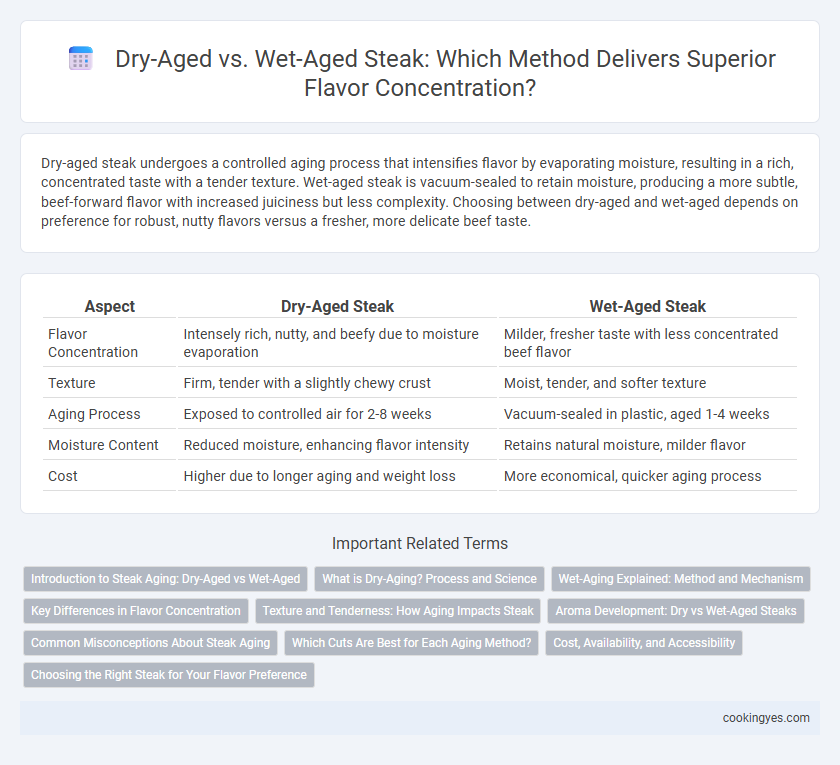Dry-aged steak undergoes a controlled aging process that intensifies flavor by evaporating moisture, resulting in a rich, concentrated taste with a tender texture. Wet-aged steak is vacuum-sealed to retain moisture, producing a more subtle, beef-forward flavor with increased juiciness but less complexity. Choosing between dry-aged and wet-aged depends on preference for robust, nutty flavors versus a fresher, more delicate beef taste.
Table of Comparison
| Aspect | Dry-Aged Steak | Wet-Aged Steak |
|---|---|---|
| Flavor Concentration | Intensely rich, nutty, and beefy due to moisture evaporation | Milder, fresher taste with less concentrated beef flavor |
| Texture | Firm, tender with a slightly chewy crust | Moist, tender, and softer texture |
| Aging Process | Exposed to controlled air for 2-8 weeks | Vacuum-sealed in plastic, aged 1-4 weeks |
| Moisture Content | Reduced moisture, enhancing flavor intensity | Retains natural moisture, milder flavor |
| Cost | Higher due to longer aging and weight loss | More economical, quicker aging process |
Introduction to Steak Aging: Dry-Aged vs Wet-Aged
Dry-aged steak undergoes a controlled aging process in a refrigerated environment with precise humidity, enhancing flavor concentration through moisture evaporation and enzymatic breakdown of muscle fibers. Wet-aged steak is vacuum-sealed in plastic, allowing the meat to retain its moisture while tenderizing over time, but with less intense flavor development compared to dry aging. The choice between dry-aged and wet-aged steak directly impacts texture, taste depth, and aroma, defining the culinary experience.
What is Dry-Aging? Process and Science
Dry-aging is a process where beef is hung in a controlled, refrigerated environment with specific humidity and airflow for several weeks, allowing natural enzymes to break down muscle tissue, intensifying flavor and tenderizing the meat. This method results in moisture evaporation, concentrating the steak's rich, beefy taste and developing a unique nutty, umami profile. The slow enzymatic and microbial actions during dry-aging create a depth of flavor and texture not achievable through wet-aging, where meat is vacuum-sealed and ages in its own juices.
Wet-Aging Explained: Method and Mechanism
Wet-aging steak involves vacuum-sealing the meat in plastic to retain moisture and allow natural enzymes to break down muscle fibers, enhancing tenderness and flavor. This process typically lasts from 7 to 28 days and preserves a juicier texture compared to dry-aging, which exposes the meat to air for flavor concentration. Wet-aging's sealed environment prevents weight loss and oxidative changes, resulting in a more mild, fresh beef taste favored in many commercial settings.
Key Differences in Flavor Concentration
Dry-aged steak develops a more intense, nutty, and complex flavor due to moisture evaporation and enzymatic breakdown, which concentrates the meat's natural taste. Wet-aged steak, stored in vacuum-sealed bags, retains more moisture, resulting in a milder and slightly metallic flavor profile with less pronounced tenderness. The key difference in flavor concentration is that dry-aging enhances depth and umami, while wet-aging preserves juiciness but offers a subtler taste.
Texture and Tenderness: How Aging Impacts Steak
Dry-aged steak develops a firmer texture and more intense, concentrated flavor due to moisture loss and enzymatic breakdown during the aging process. Wet-aged steak retains higher moisture content, resulting in a more tender, juicier bite but with a milder flavor profile. The choice between dry-aging and wet-aging depends on preference for tenderness versus robust, complex taste nuances.
Aroma Development: Dry vs Wet-Aged Steaks
Dry-aged steaks develop a rich, nutty aroma due to enzymatic breakdown and moisture evaporation, enhancing flavor concentration. Wet-aged steaks retain more moisture, resulting in a milder scent with less intense aroma development. The controlled oxidation in dry aging significantly contributes to a more complex and robust fragrance profile compared to the fresher notes found in wet aging.
Common Misconceptions About Steak Aging
Dry-aged steak develops a more intense, nutty flavor profile due to moisture evaporation and enzymatic breakdown, while wet-aged steak retains more of its original juiciness with a slightly metallic taste from vacuum-sealing. A common misconception is that dry-aging is superior in all aspects; however, wet-aging enhances tenderness by retaining natural juices without the weight loss dry-aging incurs. Understanding these distinctions helps consumers appreciate that flavor preferences depend on specific aging methods rather than one being universally better.
Which Cuts Are Best for Each Aging Method?
Dry-aged steak enhances flavor concentration in thick, bone-in cuts like ribeye and striploin, where controlled dehydration intensifies natural beef flavors and develops a nutty, umami-rich profile. Wet-aging suits tender cuts such as tenderloin and sirloin, preserving moisture while mellowing enzymes that improve texture without significant flavor loss. Selecting the optimal aging method depends on the cut's fat content, muscle structure, and desired taste intensity, with dry-aging favored for robust, marbled steaks and wet-aging for leaner, tender portions.
Cost, Availability, and Accessibility
Dry-aged steak offers a more intense, concentrated flavor due to moisture loss and enzymatic breakdown, but it comes at a higher cost and limited availability because of the lengthy aging process and specialized storage requirements. Wet-aged steak is more affordable and widely accessible, as it is vacuum-sealed and aged in its own juices, preserving tenderness but with less pronounced flavor development. Choosing between dry-aged and wet-aged steak depends on budget, flavor preference, and access to premium butchers or specialty stores.
Choosing the Right Steak for Your Flavor Preference
Dry-aged steak offers a more intense, nutty, and concentrated flavor due to moisture evaporation and enzymatic breakdown, while wet-aged steak retains a more tender texture with a milder, beefier taste. Choosing dry-aged cuts suits flavor enthusiasts seeking bold, complex profiles, whereas wet-aged is ideal for those preferring juicier, more delicate flavor nuances. Selecting between dry-aged and wet-aged depends on your preference for either robust flavor concentration or tender, fresh meat characteristics.
Dry-Aged vs Wet-Aged for flavor concentration Infographic

 cookingyes.com
cookingyes.com